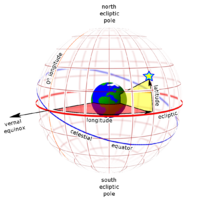Ecliptic longitude

Imagine the Earth is holding a big hula hoop around itself, and in the middle of the hula hoop is the Sun. This hula hoop is like a big circle in the sky, and we call it the ecliptic.
Now, if you're standing on the Earth and you look up at the sky, you can see lots of stars and planets. Sometimes these stars and planets are close to the ecliptic, and sometimes they're farther away.
Ecliptic longitude is a way of measuring how far away a star or planet is from the Sun on the ecliptic circle. We can imagine that the ecliptic circle is like a clock face, with the Sun at the center and the planets and stars moving around the edge.
So when we talk about a star's ecliptic longitude, we're basically saying how many minutes or hours it is away from the Sun on this clock face.
It's a handy way of keeping track of where things are in the sky and how they move over time. Scientists can use ecliptic longitude to predict when planets will be visible, or to figure out what direction they're moving in.
Overall, it's just another tool to help us better understand the vast and endlessly fascinating universe around us.
Now, if you're standing on the Earth and you look up at the sky, you can see lots of stars and planets. Sometimes these stars and planets are close to the ecliptic, and sometimes they're farther away.
Ecliptic longitude is a way of measuring how far away a star or planet is from the Sun on the ecliptic circle. We can imagine that the ecliptic circle is like a clock face, with the Sun at the center and the planets and stars moving around the edge.
So when we talk about a star's ecliptic longitude, we're basically saying how many minutes or hours it is away from the Sun on this clock face.
It's a handy way of keeping track of where things are in the sky and how they move over time. Scientists can use ecliptic longitude to predict when planets will be visible, or to figure out what direction they're moving in.
Overall, it's just another tool to help us better understand the vast and endlessly fascinating universe around us.
Related topics others have asked about:
